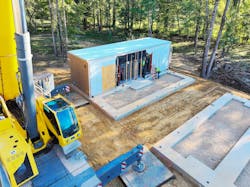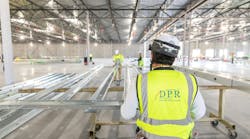7 Reasons the AI Era Depends on ILA Huts (Even If You’ve Never Heard of Them)
If you’ve wondered what’s inside those fenced-in shelters along highways and in rural settings, you’re not alone. These small structures may seem mysterious, but everyday 21st century activities like a quick internet search or a video call wouldn’t happen without them. ILA huts are quietly powering the digital world as critical components of the fiber networks that support broadband communications and connect data centers.
So what exactly is an ILA hut, and what role do they play in our digital communications landscape?
- ILA Huts Are the Workhorse of Fiber Transport
Think of an ILA facility as a mini data center. While they might seem insignificant, these shelters house the optical equipment that keeps fiber signals strong as they travel hundreds of miles. Without them, internet connections, cloud services, and AI workloads would hit a wall.
- Reducing Latency and Boosting Signals
Each ILA facility keeps data moving over great distances by amplifying the signal being carried on fiber optic cabling. In the analog days, amplifiers boosted everything including noise. But today’s fiber networks are too fast and too vast for that. Now, ILAs use laser-pumped ions to amplify light directly, keeping signals clean and fast without conversion delays. The end result is boosted signal strength, reduced latency, and lightning-fast data transmission.
- Location, Location, Location
ILA huts are typically spaced every 50–80 miles along fiber routes, often in remote areas between major cities. Because signal loss (called attenuation) builds up over distance, placing ILAs at optimal intervals, usually before the loss exceeds 23dB, keeps noise from overwhelming the signal. That’s one reason you’ll find them in cornfields, mountains, swamps, and deserts—precise placement is crucial to sustain uninterrupted transmission.
- It’s Like a Cell Tower Site (Without the Tower)
Deploying an ILA hut isn’t just plugging in a box. It starts with site acquisition to find land that’s accessible, buildable, and close enough to the fiber path. There are many other considerations like access to commercial power and securing permission from landowners and municipalities. And because these huts are often in isolated areas, the teams building them need to be agile, self-sufficient, and ready to handle everything from rocky terrain to tricky materials deliveries.
After site selection comes civil construction, which mirrors macro cell tower builds. Often, pre-fabricated shelters are set on prepared concrete pads before teams go to work fitting out the interior. Besides the racks, electronics, and cabling needed to re-amplify the data signals, power, cooling, fire suppression, and security systems are all required too, just like a scaled down data center. A coordinated team with end-to-end capabilities including site acquisition and engineering, civil construction, and inside plant (ISP) cabling and integration know-how is required to bring the ILA facility from idea to online.
- Next Evolution: Micro Data Centers
Originally, ILA huts were as small as 10x10 feet buildings geared toward low-bandwidth telco networks. But big cloud and AI companies are pushing shelter capacity limits. Lighting up 288 fiber strands might require 36 racks of gear, plus serious power and cooling. That’s why today’s ILAs are growing in size and complexity, becoming more like micro data centers. It’s not unheard of to see 24x36 foot shelters and several set on a single site.
And because of exploding AI demand, sites that were built just a few months ago may already need electronics upgrades or additional ILA facilities as service load increases and additional fiber optic cables are installed in unused ducts along the routes.
- Built by the Same Companies Driving AI and Cloud Growth
Who builds these huts? Hyperscalers are the driving force, but colocation and transport companies are doing the heavy lifting of deployment. In fact, many colocation providers are building their own fiber networks and ILAs to connect their facilities, offer better services, and reduce dependency on carriers. It can be cheaper to light their own fiber than lease it and ILAs are part of what make those routes possible.
- Future State? Unlocking Bandwidth for Rural Communities
Even though ILAs are built for backbone transport, they’re still colocation facilities. That means rural carriers could tap into them to buy bulk internet and resell it locally. As more ILAs pop up, underserved communities could gain access to high-speed bandwidth that’s been passing by just out of reach.
The Bottom Line
ILA huts may be small, but they’re mighty. They’re the heartbeat of long-haul fiber transport, quietly enabling the AI era, cloud connectivity, and the future of rural broadband. So next time you join a video call, run an AI model, or stream a movie, remember: somewhere out there, ILA huts are making it possible.
About the Author

Michael Thomas
With more than 35 years in the industry, Michael Thomas is the Regional Vice President of Integration at Network Connex, responsible for infrastructure deployment inside ILAs, hyperscale and colocation data centers, ILEC, MSO, and MTSO facilities.
Network Connex is building the world’s data backbone, delivering high-performance infrastructure solutions for data centers, fiber networks, and wireless networks.



